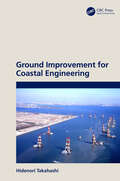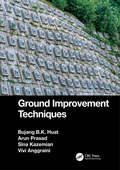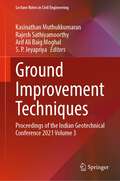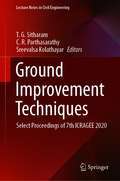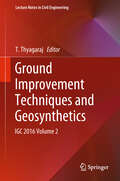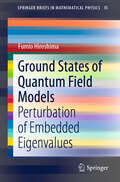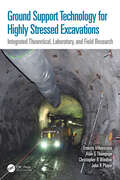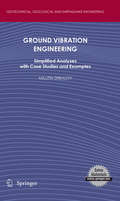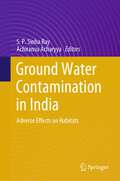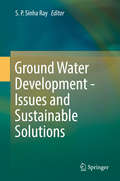- Table View
- List View
Ground Improvement for Coastal Engineering
by Hidenori TakahashiThis practical guide covers the investigation, design, and execution of ground improvement in coastal areas. It explains how to decide whether ground improvement is necessary, which method to choose, and how to design and execute it. Recognising the soft ground commonly found in coastal areas, the book introduces various ground improvement technologies including seismic reinforcement and liquefaction countermeasures and addresses the measures to be taken to sustain ground against external forces. Reliable Japanese ground improvement technologies are presented as well as the latest Building Information Modelling (BIM/Information and Communication Technology (ICT) used in their execution. The book also includes measures that can be taken against contaminated soil and considers ground improvement design on site. Unique focus on coastal applications Summarises leading edge Japanese practice The book suits professionals in the ground improvement industry, especially geotechnical designers and contractors.
Ground Improvement for Coastal Engineering
by Hidenori TakahashiThis practical guide covers the investigation, design, and execution of ground improvement in coastal areas. It explains how to decide whether ground improvement is necessary, which method to choose, and how to design and execute it. Recognising the soft ground commonly found in coastal areas, the book introduces various ground improvement technologies including seismic reinforcement and liquefaction countermeasures and addresses the measures to be taken to sustain ground against external forces. Reliable Japanese ground improvement technologies are presented as well as the latest Building Information Modelling (BIM/Information and Communication Technology (ICT) used in their execution. The book also includes measures that can be taken against contaminated soil and considers ground improvement design on site. Unique focus on coastal applications Summarises leading edge Japanese practice The book suits professionals in the ground improvement industry, especially geotechnical designers and contractors.
Ground Improvement Techniques
by Bujang B.K. Huat Arun Prasad Sina Kazemian Vivi AnggrainiThis book provides a review of problems during design and construction on problematic soils. Design methods, site investigation, construction and analysis of the various improvement methods available are explained and discussed. Various regions may have different soils with geotechnical problems that differ from those faced in other regions. For example, in Southeast Asia, the common geotechnical problems are those associated with construction on soft clays and organic soils, while in the arid region of the Middle East, problems are generally associated with the desert soils. In the US, the problems are associated with organic soils, expansive and collapsing soils, and shale. Laterite and lateritic soils are especially problematic in Mexico. Similarly, in Europe, for example, the geotechnical problems are associated with loess (France), and organic soil (Germany). A detailed description of various methods of ground improvement has been provided in 11 chapters. Each chapter deals not only with a description of the method but also focuses on region-specific ground problems and suitable ground improvement techniques. Case studies have also been included. One general chapter is dedicated to site investigation, instrumentation, assessment and control. This book will be of value to students and professionals in the fields of civil and geotechnical engineering, as well as to soil scientists and engineering geologists.
Ground Improvement Techniques
by Bujang B.K. Huat Arun Prasad Sina Kazemian Vivi AnggrainiThis book provides a review of problems during design and construction on problematic soils. Design methods, site investigation, construction and analysis of the various improvement methods available are explained and discussed. Various regions may have different soils with geotechnical problems that differ from those faced in other regions. For example, in Southeast Asia, the common geotechnical problems are those associated with construction on soft clays and organic soils, while in the arid region of the Middle East, problems are generally associated with the desert soils. In the US, the problems are associated with organic soils, expansive and collapsing soils, and shale. Laterite and lateritic soils are especially problematic in Mexico. Similarly, in Europe, for example, the geotechnical problems are associated with loess (France), and organic soil (Germany). A detailed description of various methods of ground improvement has been provided in 11 chapters. Each chapter deals not only with a description of the method but also focuses on region-specific ground problems and suitable ground improvement techniques. Case studies have also been included. One general chapter is dedicated to site investigation, instrumentation, assessment and control. This book will be of value to students and professionals in the fields of civil and geotechnical engineering, as well as to soil scientists and engineering geologists.
Ground Improvement Techniques: Proceedings of the Indian Geotechnical Conference 2021 Volume 3 (Lecture Notes in Civil Engineering #297)
by Kasinathan Muthukkumaran Rajesh Sathiyamoorthy Arif Ali Baig Moghal S. P. JeyapriyaThis book comprises the select peer-reviewed proceedings of the Indian Geotechnical Conference (IGC) 2021. The contents focus on Geotechnics for Infrastructure Development and Innovative Applications. The book covers topics related to ground improvement techniques, like stone columns, PVD, granular pile anchors, soil stabilization methods, like fly ash & chemicals, effect of biopolymer inclusion, innovative material for soil and ground improvement, among others. This volume will be of interest to those in academia and industry.
Ground Improvement Techniques: Select Proceedings of 7th ICRAGEE 2020 (Lecture Notes in Civil Engineering #118)
by T. G. Sitharam C. R. Parthasarathy Sreevalsa KolathayarThis volume presents select papers presented at the 7th International Conference on Recent Advances in Geotechnical Earthquake Engineering and Soil Dynamics. The papers discuss advances in the fields of soil dynamics and geotechnical earthquake engineering. Some of the themes include slope stability, shallow and deep foundations, geosynthetics, ground improvement techniques, etc. A strong emphasis is placed on connecting academic research and field practice, with many examples, case studies, best practices, and discussions on performance based design. This volume will be of interest to researchers and practicing engineers alike.
Ground Improvement Techniques and Geosynthetics: IGC 2016 Volume 2 (Lecture Notes in Civil Engineering #14)
by T. ThyagarajThe book comprises select proceedings of the 2016 annual conference of the Indian Geotechnical Society (IGC 2016), with technical papers on the theme “Ground Improvement and Geosynthetics”. The papers cover a wide range of topics, including chemical modification using admixtures, microbial-induced carbonate precipitation, geopolymers, fly ash and other industrial wastes, modification using geosynthetic materials such as natural and synthetic fibers, expanded polystyrene (EPS) geofoam, prefabricated vertical drains, geosynthetic encased-granular columns and mechanical densification through sand columns. This book is a valuable reference for researchers and practicing engineers alike.
Ground Motion Seismology (Advances in Geological Science)
by Kazuki KoketsuThis book explains the physics behind seismic ground motions and seismic waves to graduate and upper undergraduate students as well as to professionals. Both seismic ground motions and seismic waves are terms for “shaking” due to earthquakes, but it is common that shaking in the near-field of an earthquake source is called seismic ground motion and in the far-field is called seismic waves. Seismic ground motion is often described by the tensor formula based on the representation theorem, but in this book explicit formulation is emphasized beginning with Augustus Edward Hough Love (1863 – 1940). The book also explains in depth the equations and methods used for analysis and computation of shaking close to an earthquake source. In addition, it provides in detail information and knowledge related to teleseismic body waves, which are frequently used in the analysis of the source of an earthquake.
Ground-penetrating Radar and Magnetometry for Buried Landscape Analysis (SpringerBriefs in Geography)
by Lawrence B. ConyersThis book presents the integrated use of magnetometry and ground-penetrating radar geophysical mapping to understand the human presence within buried archaeological landscapes. Ground-penetrating radar can be used to identify buried living surfaces, geological stratigraphy and the architectural remains of sites in three-dimensions. Magnetometry can produce images denoting differences on the composition of those materials, both anthropogenic and natural, but with more limited three-dimensional resolution. The integration of the two has a unique ability to resolve and interpret these buried materials, differentiated between the human-caused and natural layers, and place all buried features within historic landscapes. The final product of geophysical integration, along with some limited subsurface testing, produces a holistic analysis of human adaptations to, and modifications of, the ancient landscape. Examples are shown from sites in Roman Croatia and Britain, Medieval Ireland, Colonial Connecticut, and an Archaic site in the Colorado Rocky Mountains. These examples from very different environments, time periods and cultural groups illustrate how the integrated geophysical methodology can interpret, on a scale approaching many hectares, the ancient landscapes within which people lived.
Ground-penetrating Radar for Geoarchaeology (Analytical Methods in Earth and Environmental Science)
by Lawrence B. ConyersThere has long been a strong collaboration between geologists and archaeologists, and the sub-field of geoarchaeology is well developed as a discipline in its own right. This book now bridges the gap between those fields and the geophysical technique of ground-penetrating radar (GPR), which allows for three-dimensional analysis of the ground to visualize both geological and archaeological materials. This method has the ability to produce images of the ground that display complex packages of materials, and allows researchers to integrate sedimentary units, soils and associated archaeological features in ways not possible using standard excavation techniques. The ability of GPR to visualize all these buried units can help archaeologists place ancient people within the landscapes and environments of their time, and understand their burial and preservation phenomena in three-dimensions. Readership: Advanced students in archaeology and geoarchaeology, as well as practicing archaeologists with an interest in GPS techniques.
Ground-penetrating Radar for Geoarchaeology (Analytical Methods in Earth and Environmental Science)
by Lawrence B. ConyersThere has long been a strong collaboration between geologists and archaeologists, and the sub-field of geoarchaeology is well developed as a discipline in its own right. This book now bridges the gap between those fields and the geophysical technique of ground-penetrating radar (GPR), which allows for three-dimensional analysis of the ground to visualize both geological and archaeological materials. This method has the ability to produce images of the ground that display complex packages of materials, and allows researchers to integrate sedimentary units, soils and associated archaeological features in ways not possible using standard excavation techniques. The ability of GPR to visualize all these buried units can help archaeologists place ancient people within the landscapes and environments of their time, and understand their burial and preservation phenomena in three-dimensions. Readership: Advanced students in archaeology and geoarchaeology, as well as practicing archaeologists with an interest in GPS techniques.
Ground States of Quantum Field Models: Perturbation of Embedded Eigenvalues (SpringerBriefs in Mathematical Physics #35)
by Fumio HiroshimaThis book provides self-contained proofs of the existence of ground states of several interaction models in quantum field theory. Interaction models discussed here include the spin-boson model, the Nelson model with and without an ultraviolet cutoff, and the Pauli–Fierz model with and without dipole approximation in non-relativistic quantum electrodynamics. These models describe interactions between bose fields and quantum mechanical matters.A ground state is defined as the eigenvector associated with the bottom of the spectrum of a self-adjoint operator describing the Hamiltonian of a model. The bottom of the spectrum is however embedded in the continuum and then it is non-trivial to show the existence of ground states in non-perturbative ways. We show the existence of the ground state of the Pauli–Fierz mode, the Nelson model, and the spin-boson model, and several kinds of proofs of the existence of ground states are explicitly provided. Key ingredients are compact sets and compact operators in Hilbert spaces. For the Nelson model with an ultraviolet cutoff and the Pauli–Fierz model with dipole approximation we show not only the existence of ground states but also enhanced binding. The enhanced binding means that a system for zero-coupling has no ground state but it has a ground state after turning on an interaction.The book will be of interest to graduate students of mathematics as well as to students of the natural sciences who want to learn quantum field theory from a mathematical point of view. It begins with abstract compactness arguments in Hilbert spaces and definitions of fundamental facts of quantum field theory: boson Fock spaces, creation operators, annihilation operators, and second quantization. This book quickly takes the reader to a level where a wider-than-usual range of quantum field theory can be appreciated, and self-contained proofs of the existence of ground states and enhanced binding are presented.
Ground Support Technology for Highly Stressed Excavations: Integrated Theoretical, Laboratory, and Field Research
by Ernesto Villaescusa Alan G Thompson Christopher R Windsor John R PlayerThe performance of ground support as a scheme is essential to constrain failures occurring at the rock surfaces of deep or highly stressed excavations. This book covers laboratory and theoretical developments coupled with field experiments and observations with the implementation of the methodology at mines. It explains the energy dissipation capabilities of reinforcement and support systems leading to the design of complete ground support schemes that can maintain integrity following the dynamic ejection of a mass of rock from an excavation boundary. The key features of the book are as follows It explores the mechanics, demand and capacity of ground support technology. It covers the whole gamut of theories, laboratory and field test results and case studies related to ground support technology. It includes a comprehensive database of mesh, rock bolts, cable bolts and shotcrete capacity. It examines ground support scheme testing and explanation. It discusses comprehensive case studies, including de-stress blasting. This book is aimed at professionals in mining engineering, including civil engineering, geological engineering and geotechnical engineering, and related advanced postgraduate studies.
Ground Support Technology for Highly Stressed Excavations: Integrated Theoretical, Laboratory, and Field Research
by Ernesto Villaescusa Alan G Thompson Christopher R Windsor John R PlayerThe performance of ground support as a scheme is essential to constrain failures occurring at the rock surfaces of deep or highly stressed excavations. This book covers laboratory and theoretical developments coupled with field experiments and observations with the implementation of the methodology at mines. It explains the energy dissipation capabilities of reinforcement and support systems leading to the design of complete ground support schemes that can maintain integrity following the dynamic ejection of a mass of rock from an excavation boundary. The key features of the book are as follows It explores the mechanics, demand and capacity of ground support technology. It covers the whole gamut of theories, laboratory and field test results and case studies related to ground support technology. It includes a comprehensive database of mesh, rock bolts, cable bolts and shotcrete capacity. It examines ground support scheme testing and explanation. It discusses comprehensive case studies, including de-stress blasting. This book is aimed at professionals in mining engineering, including civil engineering, geological engineering and geotechnical engineering, and related advanced postgraduate studies.
Ground Truth: A Guide to Tracking Climate Change at Home
by Mark L. HinelineBefore you read this book, you have homework to do. Grab a notebook, go outside, and find a nearby patch of nature. What do you see, hear, feel, and smell? Are there bugs, birds, squirrels, deer, lizards, frogs, or fish, and what are they doing? What plants are in the vicinity, and in what ways are they growing? What shape are the rocks, what texture is the dirt, and what color are the bodies of water? Does the air feel hot or cold, wet or dry, windy or still? Everything you notice, write it all down. We know that the Earth’s climate is changing, and that the magnitude of this change is colossal. At the same time, the world outside is still a natural world, and one we can experience on a granular level every day. Ground Truth is a guide to living in this condition of changing nature, to paying attention instead of turning away, and to gathering facts from which a fuller understanding of the natural world can emerge over time. Featuring detailed guidance for keeping records of the plants, invertebrates, amphibians, birds, and mammals in your neighborhood, this book also ponders the value of everyday observations, probes the connections between seasons and climate change, and traces the history of phenology—the study and timing of natural events—and the uses to which it can be put. An expansive yet accessible book, Ground Truth invites readers to help lay the groundwork for a better understanding of the nature of change itself.
Ground Truth: A Guide to Tracking Climate Change at Home
by Mark L. HinelineBefore you read this book, you have homework to do. Grab a notebook, go outside, and find a nearby patch of nature. What do you see, hear, feel, and smell? Are there bugs, birds, squirrels, deer, lizards, frogs, or fish, and what are they doing? What plants are in the vicinity, and in what ways are they growing? What shape are the rocks, what texture is the dirt, and what color are the bodies of water? Does the air feel hot or cold, wet or dry, windy or still? Everything you notice, write it all down. We know that the Earth’s climate is changing, and that the magnitude of this change is colossal. At the same time, the world outside is still a natural world, and one we can experience on a granular level every day. Ground Truth is a guide to living in this condition of changing nature, to paying attention instead of turning away, and to gathering facts from which a fuller understanding of the natural world can emerge over time. Featuring detailed guidance for keeping records of the plants, invertebrates, amphibians, birds, and mammals in your neighborhood, this book also ponders the value of everyday observations, probes the connections between seasons and climate change, and traces the history of phenology—the study and timing of natural events—and the uses to which it can be put. An expansive yet accessible book, Ground Truth invites readers to help lay the groundwork for a better understanding of the nature of change itself.
Ground Truth: A Guide to Tracking Climate Change at Home
by Mark L. HinelineBefore you read this book, you have homework to do. Grab a notebook, go outside, and find a nearby patch of nature. What do you see, hear, feel, and smell? Are there bugs, birds, squirrels, deer, lizards, frogs, or fish, and what are they doing? What plants are in the vicinity, and in what ways are they growing? What shape are the rocks, what texture is the dirt, and what color are the bodies of water? Does the air feel hot or cold, wet or dry, windy or still? Everything you notice, write it all down. We know that the Earth’s climate is changing, and that the magnitude of this change is colossal. At the same time, the world outside is still a natural world, and one we can experience on a granular level every day. Ground Truth is a guide to living in this condition of changing nature, to paying attention instead of turning away, and to gathering facts from which a fuller understanding of the natural world can emerge over time. Featuring detailed guidance for keeping records of the plants, invertebrates, amphibians, birds, and mammals in your neighborhood, this book also ponders the value of everyday observations, probes the connections between seasons and climate change, and traces the history of phenology—the study and timing of natural events—and the uses to which it can be put. An expansive yet accessible book, Ground Truth invites readers to help lay the groundwork for a better understanding of the nature of change itself.
Ground Truth: A Guide to Tracking Climate Change at Home
by Mark L. HinelineBefore you read this book, you have homework to do. Grab a notebook, go outside, and find a nearby patch of nature. What do you see, hear, feel, and smell? Are there bugs, birds, squirrels, deer, lizards, frogs, or fish, and what are they doing? What plants are in the vicinity, and in what ways are they growing? What shape are the rocks, what texture is the dirt, and what color are the bodies of water? Does the air feel hot or cold, wet or dry, windy or still? Everything you notice, write it all down. We know that the Earth’s climate is changing, and that the magnitude of this change is colossal. At the same time, the world outside is still a natural world, and one we can experience on a granular level every day. Ground Truth is a guide to living in this condition of changing nature, to paying attention instead of turning away, and to gathering facts from which a fuller understanding of the natural world can emerge over time. Featuring detailed guidance for keeping records of the plants, invertebrates, amphibians, birds, and mammals in your neighborhood, this book also ponders the value of everyday observations, probes the connections between seasons and climate change, and traces the history of phenology—the study and timing of natural events—and the uses to which it can be put. An expansive yet accessible book, Ground Truth invites readers to help lay the groundwork for a better understanding of the nature of change itself.
Ground Truth: A Guide to Tracking Climate Change at Home
by Mark L. HinelineBefore you read this book, you have homework to do. Grab a notebook, go outside, and find a nearby patch of nature. What do you see, hear, feel, and smell? Are there bugs, birds, squirrels, deer, lizards, frogs, or fish, and what are they doing? What plants are in the vicinity, and in what ways are they growing? What shape are the rocks, what texture is the dirt, and what color are the bodies of water? Does the air feel hot or cold, wet or dry, windy or still? Everything you notice, write it all down. We know that the Earth’s climate is changing, and that the magnitude of this change is colossal. At the same time, the world outside is still a natural world, and one we can experience on a granular level every day. Ground Truth is a guide to living in this condition of changing nature, to paying attention instead of turning away, and to gathering facts from which a fuller understanding of the natural world can emerge over time. Featuring detailed guidance for keeping records of the plants, invertebrates, amphibians, birds, and mammals in your neighborhood, this book also ponders the value of everyday observations, probes the connections between seasons and climate change, and traces the history of phenology—the study and timing of natural events—and the uses to which it can be put. An expansive yet accessible book, Ground Truth invites readers to help lay the groundwork for a better understanding of the nature of change itself.
Ground Truth: A Guide to Tracking Climate Change at Home
by Mark L. HinelineBefore you read this book, you have homework to do. Grab a notebook, go outside, and find a nearby patch of nature. What do you see, hear, feel, and smell? Are there bugs, birds, squirrels, deer, lizards, frogs, or fish, and what are they doing? What plants are in the vicinity, and in what ways are they growing? What shape are the rocks, what texture is the dirt, and what color are the bodies of water? Does the air feel hot or cold, wet or dry, windy or still? Everything you notice, write it all down. We know that the Earth’s climate is changing, and that the magnitude of this change is colossal. At the same time, the world outside is still a natural world, and one we can experience on a granular level every day. Ground Truth is a guide to living in this condition of changing nature, to paying attention instead of turning away, and to gathering facts from which a fuller understanding of the natural world can emerge over time. Featuring detailed guidance for keeping records of the plants, invertebrates, amphibians, birds, and mammals in your neighborhood, this book also ponders the value of everyday observations, probes the connections between seasons and climate change, and traces the history of phenology—the study and timing of natural events—and the uses to which it can be put. An expansive yet accessible book, Ground Truth invites readers to help lay the groundwork for a better understanding of the nature of change itself.
Ground Vibration Engineering: Simplified Analyses with Case Studies and Examples (Geotechnical, Geological and Earthquake Engineering #12)
by Milutin SrbulovGround vibration consideration is gaining significance with people’s decreasing tolerance of vibration, introduction of new environmental legislations, increasing use of equipment sensitive to vibration, ageing of existing buildings and expanding construction sites to/near collapsible/liquefiable/thixotropic soil.This volume bridges the gap that exists between rather limited provisions of engineering codes/standards and complex numerical analyses/small-scale tests.The book contains descriptions of ground vibration measurements, predictions and control for engineers. Effects of most frequent sources of ground vibration arising from construction/demolition, traffic and machinery, ground wave amplification and attenuation as well as foundation kinematic and inertial interaction have been considered by simplified analyses aimed at ease and speed of use for major problems in ground vibration engineering. Comments on assumptions, limitations, and factors affecting the results are given. Case studies and examples worldwide are included to illustrate the accuracy and usefulness of simplified methods. A list of references is provided for further consideration, if desired.Audience: This work is of interest to geotechnical engineers, engineering geologists, earthquake engineers and students. Extra material: Microsoft Excel spreadsheets with the input data and results for the case studies and examples considered in this book are available at http://extras.springer.com
Ground Water Contamination in India: Adverse Effects on Habitats
by Achiransu Acharyya S. P. Sinha RayThis book examines contamination in groundwater. Groundwater is a lifeline for most countries of the world. 90% of the Indian population rely on groundwater-based drinking water as safe mode of water supply. The terminology contamination in groundwater along with adverse effect on habitats, suggests the impact of such contamination in not only for drinking water, but also for agricultural irrigation. In addition, polluted groundwater causes adverse health hazards including social aspects that affect wider communities. Impacts on plant life also are equally threatening. This book provides readers with an insight into groundwater contamination in India. The economic loss associated with this devastating phenomenon is also studied in detail, which has a direct bearing to the country's GDP.
Ground Water Development - Issues and Sustainable Solutions
by S. P. RayGround water resources are receiving global attention, as human population growth and development cause significant changes to the earth system. It plays a major role in ensuring livelihood security in many parts of South Asia and its contribution to poverty alleviation is substantial. The complex nature of ground water problems in the Indian Sub-continent requires a precise delineation of the ground water regimes in different hydro geological settings and socio-economic conditions and is a primary necessity for sustainable and equitable management. Strategies to respond to ground water over-exploitation and deteriorating water quality must be based on a new approach. Practical policies and various solution options urgently need to be formulated and implemented to prevent the development problems. There is pressing need to evolve workable methods and approaches based on modern scientific researches on ground water resources, as well as to build a social framework including community participation at all levels for a ground water development system. The community participation in water pumping policies, incentives of efficient use, affordability of low income users and other vulnerable groups, water awareness are prime factors for success of any ground water based water supply project.
Ground Work: Writings on People and Places
by Richard Holmes Tim DeeWe are living in the anthropocene – an epoch where everything is being determined by the activities of just one soft-skinned, warm-blooded, short-lived, pedestrian species. How best to make our way through the ruins that we have made? This anthology of commissioned work tries to answer this as it explores new and enduring cultural landscapes, in a celebration of local distinctiveness that includes new work from some of our finest writers. We have memories of childhood homes from Adam Thorpe, Marina Warner and Sean O’Brien; we journey with John Burnside to the Arizona desert, with Hugh Brody to the Canadian Arctic; going from Tessa Hadley’s hymn to her London garden to caving in the Mendips with Sean Borodale to shell-collecting on a Suffolk beach with Julia Blackburn.Helen Macdonald, in her remarkable piece on growing up in a 50-acre walled estate, reflects on our failed stewardship of the planet: ‘I take stock.’ she says, ‘During this sixth extinction, we who may not have time to do anything else must write now what we can, to take stock.’ This is an important, necessary book.
Groundbreakers: The Return of Britain’s Wild Boar
by Chantal Lyons'Full of joy, pathos, warmth, integrity and intrigue.' AMY-JANE BEER'A thrilling expedition into a wild, unruly world.' LEE SCHOFIELD 'Gently thought-provoking and beautifully written.' LEIF BERSWEDEN'A real page-turner.' STEPHEN MOSSAfter centuries of absence, wild boar are back in Britain. What does this mean for us – and them?Big, messy and mysterious – crossing paths with a wild boar can conjure fear and joy in equal measure. Driven to extinction seven hundred years ago, a combination of the species' own tenacity and illegal releases from the 1980s has seen several populations of this beast of myth begin to roam English and Scottish woods once more.With growing worry over the impacts on both people and the countryside, the boar's right to exist in Britain has been heavily debated. Their habitat-regenerating actions benefit a host of other wildlife, yet unlike beavers, these ecosystem engineers remain unloved by many. Why is there no clamour to reintroduce them across the land? And, with the few boar in England threatened by poaching and culling, why are we not doing more to prevent their re-extinction? In Groundbreakers, Chantal Lyons moves to the boar's stronghold of the Forest of Dean to get up close and personal with this complex, intelligent and quirky species, and she meets with people across Britain and beyond who celebrate their presence – or want them gone. From Toulouse and Barcelona where they are growing in number and boldness, to the woods of Kent and Sussex where they are fading away again, to Inverness-shire where rewilders welcome them, join Chantal on a journey of discovery as she reveals what it might take for us to coexist with wild boar.
